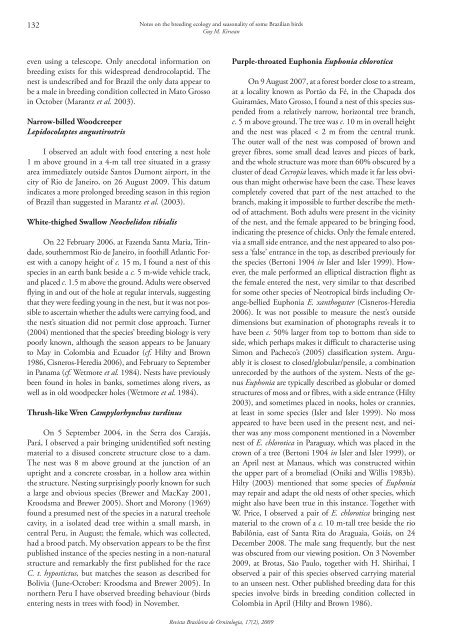art01 - omena júnior.indd - Sociedade Brasileira de Ornitologia
art01 - omena júnior.indd - Sociedade Brasileira de Ornitologia
art01 - omena júnior.indd - Sociedade Brasileira de Ornitologia
- No tags were found...
Create successful ePaper yourself
Turn your PDF publications into a flip-book with our unique Google optimized e-Paper software.
132 Notes on the breeding ecology and seasonality of some Brazilian birdsGuy M. Kirwaneven using a telescope. Only anecdotal information onbreeding exists for this wi<strong>de</strong>spread <strong>de</strong>ndrocolaptid. Thenest is un<strong>de</strong>scribed and for Brazil the only data appear tobe a male in breeding condition collected in Mato Grossoin October (Marantz et al. 2003).Narrow-billed WoodcreeperLepidocolaptes angustirostrisI observed an adult with food entering a nest hole1 m above ground in a 4‐m tall tree situated in a grassyarea immediately outsi<strong>de</strong> Santos Dumont airport, in thecity of Rio <strong>de</strong> Janeiro, on 26 August 2009. This datumindicates a more prolonged breeding season in this regionof Brazil than suggested in Marantz et al. (2003).White-thighed Swallow Neochelidon tibialisOn 22 February 2006, at Fazenda Santa Maria, Trinda<strong>de</strong>,southernmost Rio <strong>de</strong> Janeiro, in foothill Atlantic Forestwith a canopy height of c. 15 m, I found a nest of thisspecies in an earth bank besi<strong>de</strong> a c. 5 m-wi<strong>de</strong> vehicle track,and placed c. 1.5 m above the ground. Adults were observedflying in and out of the hole at regular intervals, suggestingthat they were feeding young in the nest, but it was not possibleto ascertain whether the adults were carrying food, andthe nest’s situation did not permit close approach. Turner(2004) mentioned that the species’ breeding biology is verypoorly known, although the season appears to be Januaryto May in Colombia and Ecuador (cf. Hilty and Brown1986, Cisneros-Heredia 2006), and February to Septemberin Panama (cf. Wetmore et al. 1984). Nests have previouslybeen found in holes in banks, sometimes along rivers, aswell as in old woodpecker holes (Wetmore et al. 1984).Thrush-like Wren Campylorhynchus turdinusOn 5 September 2004, in the Serra dos Carajás,Pará, I observed a pair bringing uni<strong>de</strong>ntified soft nestingmaterial to a disused concrete structure close to a dam.The nest was 8 m above ground at the junction of anupright and a concrete crossbar, in a hollow area withinthe structure. Nesting surprisingly poorly known for sucha large and obvious species (Brewer and MacKay 2001,Kroodsma and Brewer 2005). Short and Morony (1969)found a presumed nest of the species in a natural treeholecavity, in a isolated <strong>de</strong>ad tree within a small marsh, incentral Peru, in August; the female, which was collected,had a brood patch. My observation appears to be the firstpublished instance of the species nesting in a non-naturalstructure and remarkably the first published for the raceC. t. hypostictus, but matches the season as <strong>de</strong>scribed forBolivia (June-October: Kroodsma and Brewer 2005). Innorthern Peru I have observed breeding behaviour (birdsentering nests in trees with food) in November.Purple-throated Euphonia Euphonia chloroticaOn 9 August 2007, at a forest bor<strong>de</strong>r close to a stream,at a locality known as Portão da Fé, in the Chapada dosGuiramães, Mato Grosso, I found a nest of this species suspen<strong>de</strong>dfrom a relatively narrow, horizontal tree branch,c. 5 m above ground. The tree was c. 10 m in overall heightand the nest was placed < 2 m from the central trunk.The outer wall of the nest was composed of brown andgreyer fibres, some small <strong>de</strong>ad leaves and pieces of bark,and the whole structure was more than 60% obscured by acluster of <strong>de</strong>ad Cecropia leaves, which ma<strong>de</strong> it far less obviousthan might otherwise have been the case. These leavescompletely covered that part of the nest attached to thebranch, making it impossible to further <strong>de</strong>scribe the methodof attachment. Both adults were present in the vicinityof the nest, and the female appeared to be bringing food,indicating the presence of chicks. Only the female entered,via a small si<strong>de</strong> entrance, and the nest appeared to also possessa ‘false’ entrance in the top, as <strong>de</strong>scribed previously forthe species (Bertoni 1904 in Isler and Isler 1999). However,the male performed an elliptical distraction flight asthe female entered the nest, very similar to that <strong>de</strong>scribedfor some other species of Neotropical birds including Orange-belliedEuphonia E. xanthogaster (Cisneros-Heredia2006). It was not possible to measure the nest’s outsi<strong>de</strong>dimensions but examination of photographs reveals it tohave been c. 50% larger from top to bottom than si<strong>de</strong> tosi<strong>de</strong>, which perhaps makes it difficult to characterise usingSimon and Pacheco’s (2005) classification system. Arguablyit is closest to closed/globular/pensile, a combinationunrecor<strong>de</strong>d by the authors of the system. Nests of the genusEuphonia are typically <strong>de</strong>scribed as globular or domedstructures of moss and or fibres, with a si<strong>de</strong> entrance (Hilty2003), and sometimes placed in nooks, holes or crannies,at least in some species (Isler and Isler 1999). No mossappeared to have been used in the present nest, and neitherwas any moss component mentioned in a Novembernest of E. chlorotica in Paraguay, which was placed in thecrown of a tree (Bertoni 1904 in Isler and Isler 1999), oran April nest at Manaus, which was constructed withinthe upper part of a bromeliad (Oniki and Willis 1983b).Hilty (2003) mentioned that some species of Euphoniamay repair and adapt the old nests of other species, whichmight also have been true in this instance. Together withW. Price, I observed a pair of E. chlorotica bringing nestmaterial to the crown of a c. 10 m-tall tree besi<strong>de</strong> the rioBabilônia, east of Santa Rita do Araguaia, Goiás, on 24December 2008. The male sang frequently, but the nestwas obscured from our viewing position. On 3 November2009, at Brotas, São Paulo, together with H. Shirihai, Iobserved a pair of this species observed carrying materialto an unseen nest. Other published breeding data for thisspecies involve birds in breeding condition collected inColombia in April (Hilty and Brown 1986).Revista <strong>Brasileira</strong> <strong>de</strong> <strong>Ornitologia</strong>, 17(2), 2009
















